
In the dim light of an office with green-plastered walls, 67-year-old Almoustapha Alhacen leans over some documents. He wears a white tagelmust (turban) and a turquoise blue boubou that stands out in the darkness. His finger traces a document, while in his other hand he holds a pair of glasses through which one can see a meticulous and concentrated gaze. He opens an aluminum briefcase containing a scintillometer, an instrument used to measure radioactivity levels. After checking the batteries, he takes the briefcase, goes outside, and gets into his car to drive into the streets of Arlit, a city of nearly 200,000 inhabitants located in northern Niger. Having received a call reporting ’suspicious" waste on the city’s scrap metal market, he goes there to investigate.
Arlit is located in an extremely arid area of the Sahara, in the Agadez region. Dust and plastic waste are ubiquitous, as is the chaotic coming and going of tuk-tuks, motorcycles, and trucks. Apart from a few small shops, the region’s economy revolves entirely around mining.
Being able to visit these places is a rare experience for journalists, both because of the insecurity caused by jihadist groups operating in the Sahel, but especially because local authorities are reluctant to allow reporters to go to this area. This was possible for a short period, thanks to the military coup that took place in July 2023.
Mountains of polluted scrap metal
In this desert plain, where once only livestock and caravans passed, permanent settlements emerged after the discovery of large uranium deposits and their exploitation in the early 1970s. This is how Arlit and its satellite town of Akokan sprang up from nowhere. When French mining companies established colonies to accommodate the families of the thousands of workers they needed, their presence triggered the sedentarization of nomadic communities.
Almoustapha Alhacen recounts that he was born in Aouderas, a village located in the desert, 350 km from here, and that when he was still a child, his father decided to settle in Arlit. As he tells his story, the car winds its way through the meanders of the city to the mechanics and scrap metal dealers’ quarter. Porters and handymen push wheelbarrows and load motorcycles with spare parts recovered from mountains of scrap metal. Behind, the black smoke from waste burned in the dumps rises into the sky. Almoustapha is greeted by a man who claims to have bought a load of scrap metal from individuals without knowing exactly where they had recovered it. So he called Almoustapha as a precaution. Almoustapha prepares the scintillometer and begins to rummage through a pile of rusty pipes. “This time, the instrument does not indicate dangerous radiation levels,” he notes, relieved.
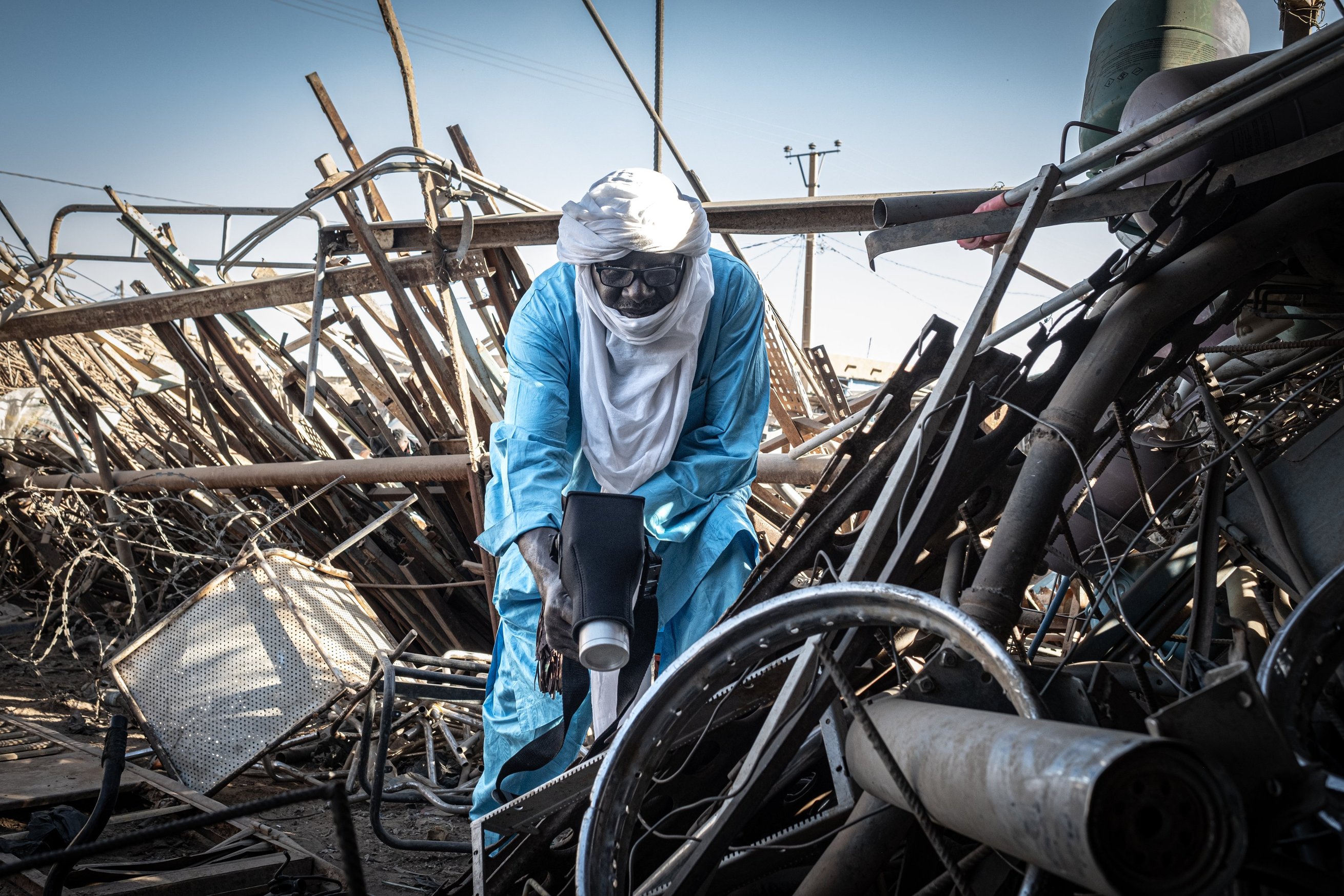
This Tuareg carries out this activity with other members of the NGO Aghirin’man, which he founded in 2002 to protect the rights of the population and denounce the environmental impact of uranium mining in the Arlit region. Over the years, tons of radioactive scrap metal have been found on the markets and reused by the community. ’[The recorded levels] sometimes exceed hundreds of times the usual levels of beta-gamma radiation or are contaminated with uranium, radium-226 or lead-210. This is maintenance waste from the two nearby mines", he explains.
Many controversies
The two mining sites around which the city lives are located a few hundred meters away. The Société des Mines de l’Aïr (Somaïr) mine, active since 1971, is a vast open-pit sedimentary deposit, 50 to 70 meters deep, producing 2,000 tons of uranium per year. Somaïr is 63.4 % owned by Orano and 36.6 % by the Société du Patrimoine des Mines du Niger (Sopamin). Orano is a French state-owned company specializing in nuclear fuels, created in 2018 after the dismantling of the large French multinational Areva, which had managed the site for decades.
The second site, called Akouta, is located in Akokan, about 7 km from Arlit. Here too, the exploitation is in the hands of Orano, which holds 59 % of the Compagnie minière d’Akouta (Cominak), while 31 % is held by Sopamin and 10 % by the Spanish firm Enusa (Enusa Industrias Avanzadas SA). This deposit produced 75,000 tons of uranium between the beginning of its exploitation in 1978 and its closure in 2021. It is an underground mine more than 200 meters deep with one of the largest tunnel networks in the world, over 250 km.
The operation of these two sites has been at the center of numerous controversies over the past twenty years due to the lack of transparency of the mining companies, often denounced for their environmental and social negligence1. In recent months, Orano has been in even greater difficulty due to the deterioration of relations between the military in power and France. Activists like Almoustapha are worried that the company could leave behind a mess if it were to be suddenly expelled.
Radioactivity everywhere
Leaving the scrap metal market, the activist wants to show one of the ’hotspots" he recently discovered in the city. The old SNTN transport company depot, in the center of Arlit, consists of large abandoned warehouses containing rusty buses and dilapidated offices. Residents, who use it as a shortcut, cross it constantly. Goats and donkeys graze there and groups of children often play there.
Almoustapha points the scintillometer towards certain points on the ground. The instrument’s beep begins to increase, and levels 10 to 20 times higher than normal appear on the screen. The activist explains that the depot’s soil has been compacted using waste from the mines. “This area should be rehabilitated, like many others in the city”, he emphasizes.
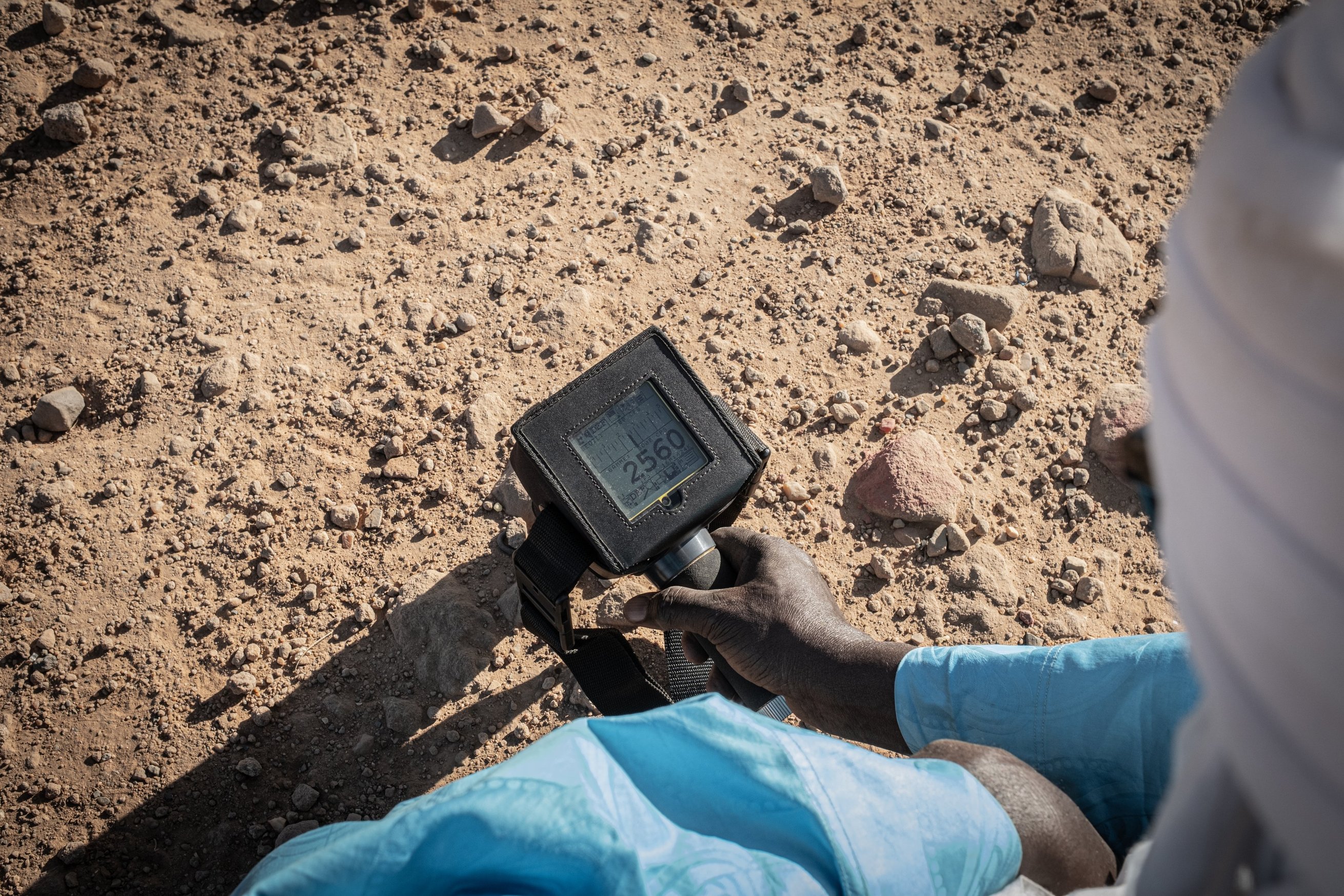
Over the years, his NGO and other organizations have discovered numerous cases where radioactive waste has been used in the construction of buildings. According to Almoustapha, “[they] have also observed this situation in front of one of the hospitals. There are people who live constantly exposed without knowing it because the radioactivity is inside the walls of their homes”. Activists have regularly alerted the authorities and mining companies, who reluctantly launched the “counter plan” in 2010 in order to raise awareness among the population, strengthen radiological monitoring of these materials and map anomalies in the city (before demolishing polluted buildings and rebuilding new ones).
According to Orano, the various phases of the plan concerning Akokan were completed in March 2024. The company claims to have treated more than 40 houses, while work is still ongoing in Arlit. However, according to activists and residents, there are still dozens of houses marked as dangerous, and the mapping is not complete. According to them, while Orano claims to have checked more than 5,000 buildings, the number of those identified as radioactive is unclear, making the results of the program opaque2.
“Unfortunately, this is just the tip of the iceberg”, laments Almoustapha as he drives the car northwest towards the neighborhoods on the outskirts of the city. The activist points to what looks like hills, about a kilometer away. “Over there, there’s the Somaïr mine, and what you see are mountains of rocks and materials from the excavations. It’s millions of cubic meters, and they’re right next to us.”
“We are in the Sahara, there is always wind”
In open-pit uranium mines, dynamite and huge excavation equipment are used on a large scale, and the waste is generally piled up on the sides of the site. This is not ordinary rock and dust. These debris do not contain quantities of uranium of interest for mining, but they still emit dangerous amounts of radioactivity into the environment.
Almoustapha points out that behind the first hills, one can see enormous gray mounds with yellowish and whitish veins : “These are harmful radioactive sludges. We are in the Sahara, there is always wind, and during sandstorms the dust spreads everywhere in the air, even when there is no work or explosive charges. All this has been happening for decades.”
The sludge comes from the treatment of rocks extracted from the subsoil. Various chemical leaching steps allow the extraction of what is called “yellowcake”, which is then enriched and transformed into fuel for nuclear power plants. Before the coup d’état of July 2023, the ore from these sites was transported overland to the port of Cotonou in Benin, then by sea to Le Havre in France, where it was transformed into nuclear fuel in the two Orano refineries, in Malvesì and Pierrelatte. After the coup, Orano’s subsidiaries in Niger suspended their exports. “All this will remain for thousands of years”, Almoustapha fumes.
“I understood that they weren’t telling us the truth”
The old activist was employed for decades in both mines. In 1978, as soon as he was old enough to work, he was hired by Cominak, then by Somaïr, where he worked until 2015. “It was very hard work. I was always in contact with dust that almost killed me.” In the late 1990s, he fell seriously ill with tuberculosis and was assigned to radiation control. “That’s when I realized what we were living through. I understood that they weren’t telling us the truth. The most exposed workers were the first to get sick and die.”
In 2000, while still employed, he began to campaign both inside and outside the mine. From then on, the pressure increased. The company tried to fire him, and the local authorities openly opposed him. But it was also from this moment that the truths hidden for years began to be revealed. His NGO, Aghirin’man, involved experts from Sherpa and Greenpeace, who requested the Independent Research and Information Commission on Radioactivity (Criirad) to analyze the samples taken. This organization assesses the risks associated with radioactivity and the impact of French nuclear activities on health and the environment.
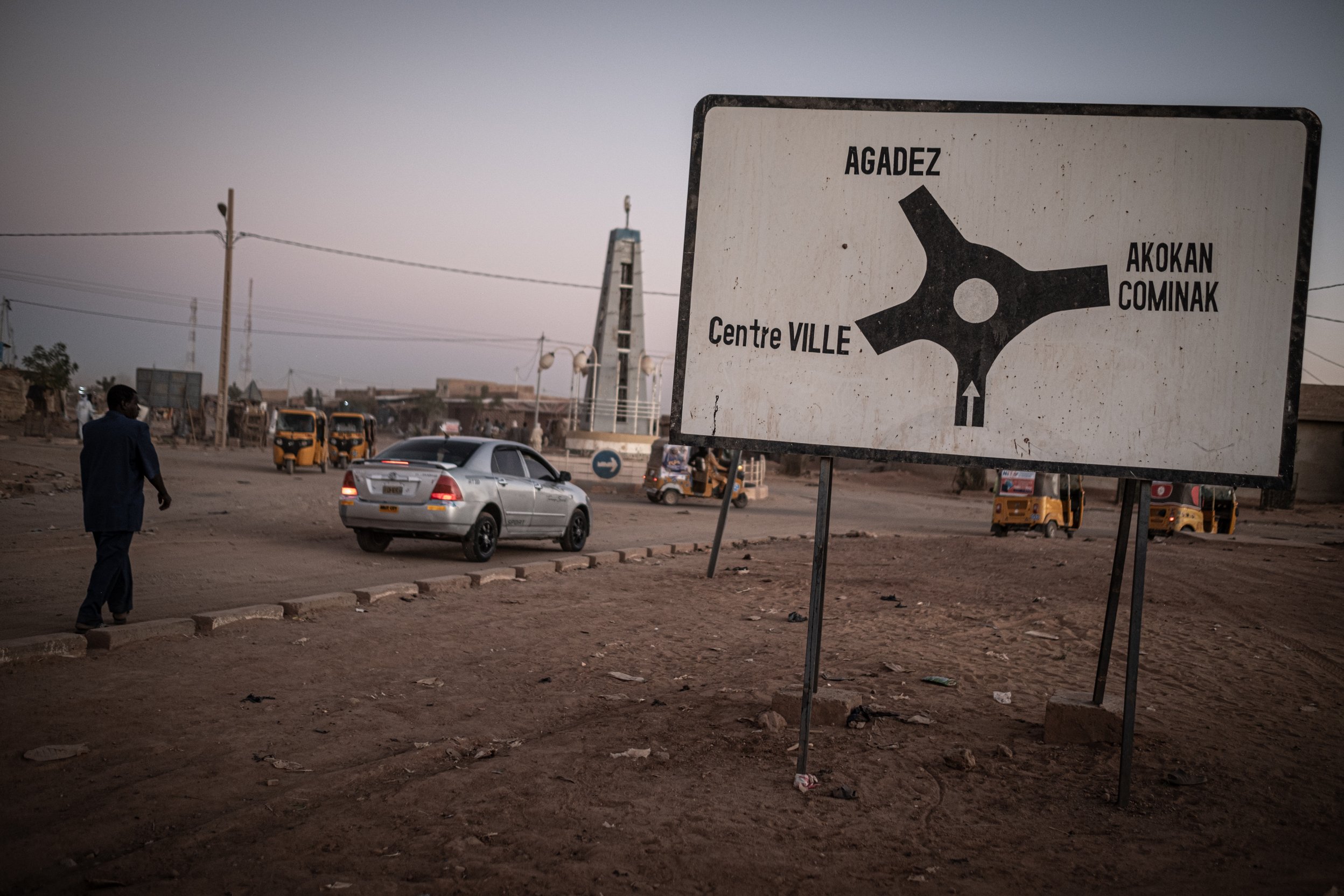
For Criirad, as for Greenpeace, the population of Arlit has been subjected to chronic radioactive contamination for decades. Even the water consumed in the localities has been infectedby the mines. Indeed, according to the conclusions of Criirad, groundwater is heavily contaminated (with an alpha radioactivity index 10 to 100 times higher than the values recommended by the World Health Organization) by chemicals, including radon. In addition to radioactivity, heavy metals such as uranium have a very high degree of toxicity, which is extremely dangerous, especially for groundwater. Researchers have had access to internal Areva documents confirming the presence of high levels of contamination.
Orano’s “inaccuracies”
This situation is all the more worrying when one knows that uranium extraction requires large quantities of water. Hundreds of millions of liters are needed each year to separate uranium from other minerals. However, this contaminated water can no longer be potable. The water used by mining companies is pumped from the Tarat aquifer. This is a fossil aquifer: the resource is therefore not easily renewable. It takes thousands of years, or even more, before it fills up again. Consequently, according to activists and researchers, mining is leading to a decrease in water resources in a region, the Sahel, where the climate crisis has severe consequences in terms of rainfall and drought.
Orano, and Areva before it, have consistently maintained that everything has been up to standards and certified since the early 2000s. On its website, it boasts the safety of its workers, periodic analyses of air and the food chain, and the presence of a groundwater aquifer monitoring program (Aman)... It further claims that water consumption from its mines has decreased by 35 % in fifteen years. However, all these claims are the result of analyses and investigations produced or commissioned by Somaïr and Cominak themselves, which, according to independent experts, present “inaccuracies” and “imprecise evaluation coefficients”.
“Orano is very skilled at communication, providing summary information that is sufficient to distort reality and make the general public believe that there is no pollution in Niger and that everything is normal, even though the scientific evidence, often produced by itself, contradicts it”, explains Bruno Chareyron, the director of the Criirad laboratory, who personally handled the Arlit-Akokan case. For the scientist, there is a “disturbing discrepancy” with reality: “In Arlit and Akokan, there are people who have been living in a radioactive environment since childhood, and it is worrying that all the impacts have not been documented”. Criirad would like to take more samples and conduct more examinations and analyses, but all this requires resources and authorizations that are difficult to obtain.
Tomorrow’s anxiety
Recently, interest in these issues was revived with the official closure of the Cominak mine in March 2021, after forty-seven years of operation. The news sparked anxiety among civil society. More than 1,400 people found themselves unemployed. But what is even more worrying is the environmental legacy that the mine is leaving behind. Indeed, more than 20 million tons of radioactive sludge, which is now in the open air a few kilometers from inhabited areas, will have to be remediated and cleaned up.
Orano has made several promises, stating that it will take care of its former employees and rehabilitate the area by securing the toxic waste through works that will last more than twelve years. Their cost, estimated at 95 billion CFA francs (nearly 145 million euros), has been validated by the Nigerien authorities. However, civil society remains very skeptical.
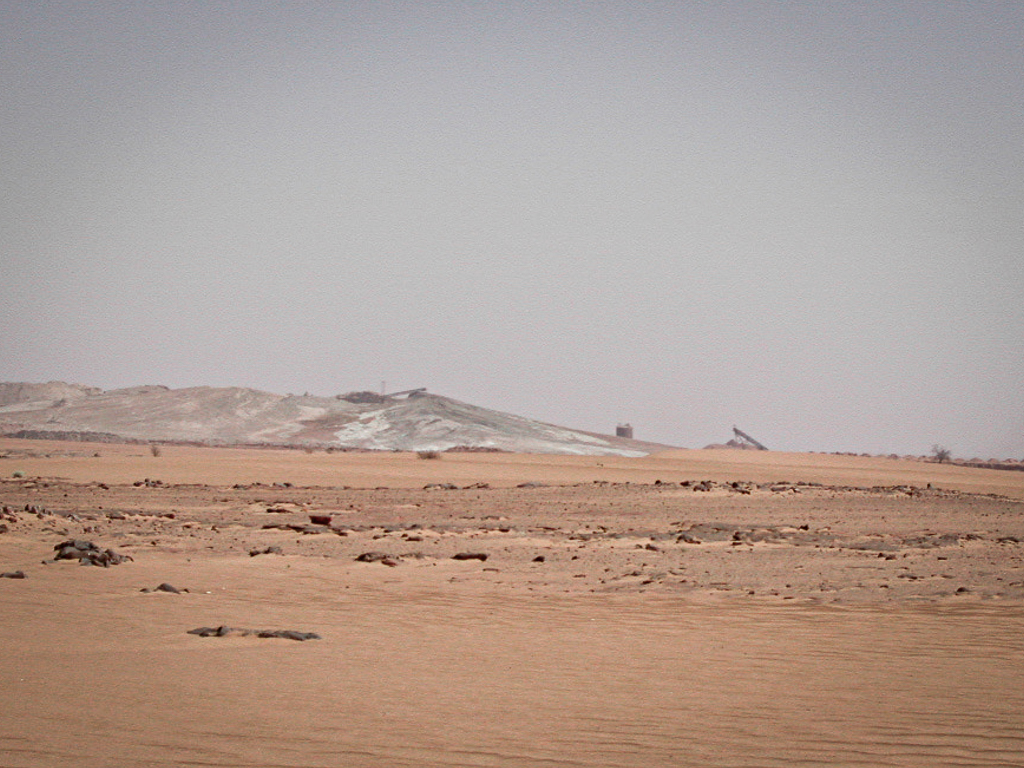
In its rehabilitation plan, Orano states that it wants to cover the sludge with a three-meter-thick clay sarcophagus with a possible concrete coating. According to the company, this intervention has already been used elsewhere and will be sufficient. But Criirad disagrees. “We measured them and they have an activity well above 100,000 becquerels [the unit of measurement of the activity of a radionuclide in the International System] and can be classified as “low-level” and ’long-lived’ waste”, says Bruno Chareyron. According to him, the sludge “should have been stored in confined sites from the beginning”.
For activists and researchers, the clay layer will not be sufficient in the long term, and the underlying aquifers are at risk of further contamination. Cominak representatives have even suggested that infiltrations into an aquifer have been occurring since 2006. As early as 2011, Cominak is said to have started pumping water contaminated by radioactive sludge into a surface basin in an attempt to contain the contamination. According to activists, the contaminated water is likely to reach the drinking water pumping stations for Arlit, which are located a short distance away, as shown in a 2020 Cominak report that Criirad became aware of in 2023.
Ghost town
The town of Akokan is located near the entrance to the mine, whose galleries will be filled with water and sealed. Built in the 1970s, it is a large camp designed to accommodate Cominak’s managers and workers. The houses all have the same structure and are painted a light crimson plaster with blue doors. On each doorpost, one can still find numbers and initials corresponding to the rank of the employee to whom the house was assigned, such as “RA, African residence”.
Now that the mine is closed, Akokan has become a ghost town suspended in time. Under the arcades, the entrances to what were once workshops for the employees are barred. All the walls of the buildings are encrusted and full of cracks due to the vibrations of the dynamite charges. A dystopian landscape with deserted streets, except for a few small groups of elderly people chatting over tea or a blue-collar worker returning home.
Aichatou Boubacar Kadri sweeps the entrance to one of the last restaurants. Two years ago, she lost her husband, who was only 42 years old, a mechanic at Cominak who had worked in the mine for fifteen years. “His name was Hachimou and he had always worked underground. They laid him off in October, just before the closure, then called him back for the restoration, but he fell ill. Fever, cough... At the hospital, they couldn’t say what he had. He died in a short time and I don’t know why.”
Almoustapha listens to the woman’s story and explains that many people are sent home with “inconsistent and superficial” medical evaluations. Some die without being diagnosed, due to lack of resources. There are currently only two hospitals available to the population in the region, that of Somaïr and that of Cominak.
Zero deaths, zero illnesses, according to Orano
In 2009, Criirad and Greenpeace gained access to a 2000 studyconducted by Cominak itself, which indicated a mortality rate from respiratory infections in the city of Arlit twice as high as the national average (16.19 %, compared to 8.54 %). However, Orano (and previously Areva) continues to claim (including through commissioned studies) that there are no work-related illnesses among its employees and that there are no statistical anomalies in mortality rates. According to Bruno Chareyron, “these claims are absurd, as the incidence of these diseases on mining sites is proven worldwide. Given the working conditions that have prevailed for decades in these two mines, it is absolutely impossible that there have been no cases”.
In the midst of the dilapidated houses of Akokan, Aichatou points to the house where a former Cominak worker now lives, gravely ill. The door is opened by Bibata. This woman in her fifties is caring for her husband, Issaka Alzouma, who worked in the mine for thirty-eight years. The man, of large build, is not lucid, he has difficulty getting out of bed and is supported by one of his sons. Bibata explains that he has leg pain and difficulty breathing, and that he is probably suffering from Alzheimer’s disease.
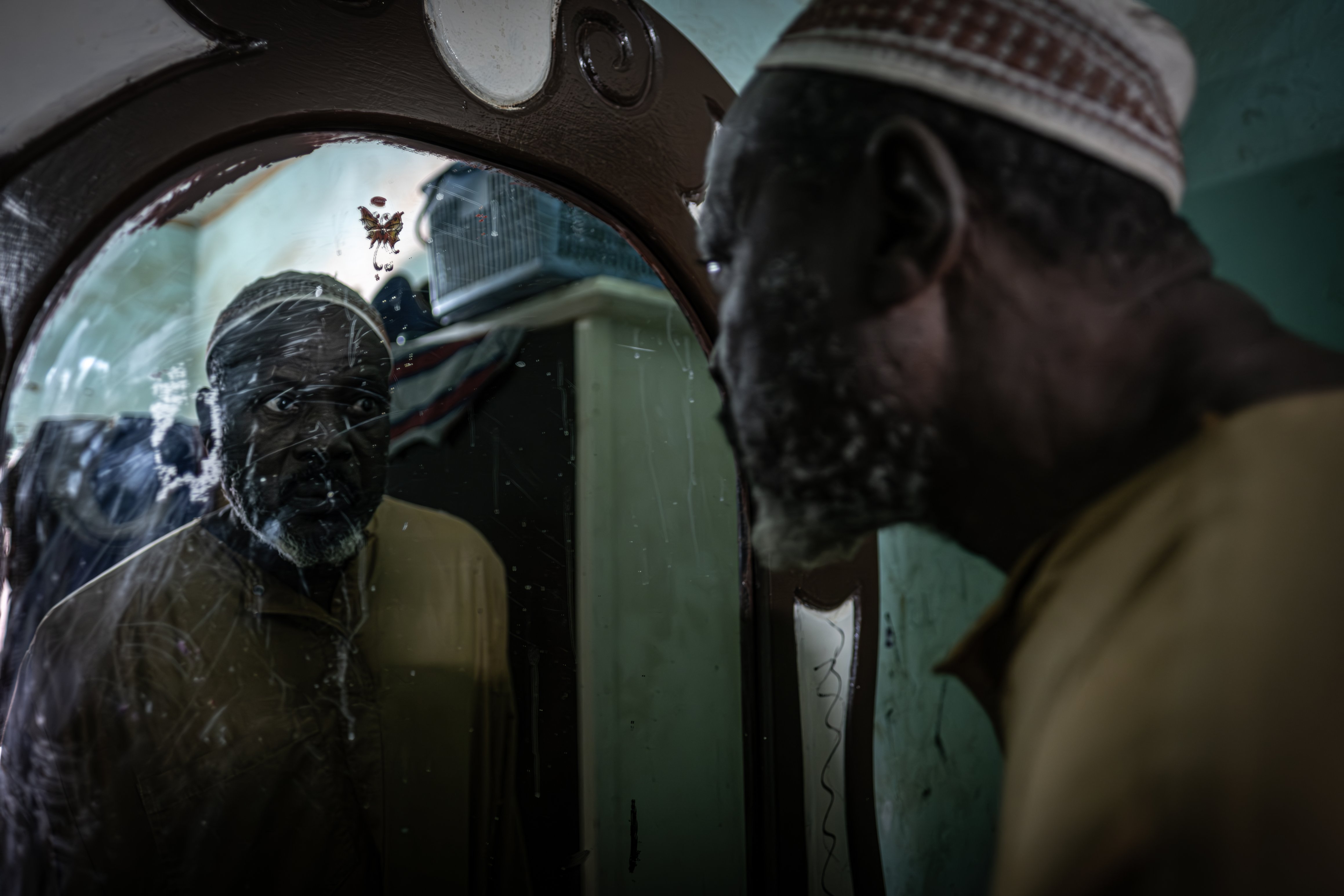
“Before, we lived well. Today, the situation is very difficult because we receive his pension every quarter and our children don’t have jobs”, explains the woman who says she can’t afford medical treatment. “Before, when he was working, he was covered by the company, but that’s no longer the case today.”
Orano claims that the inhabitants of Arlit and Akokan “benefit from free medical care” in its two hospitals, but several testimonies collected on site tell a very different story. The Cominak hospital in Akokan is no longer free for people over 5 years old since 2022, and it lacks adequate medical equipment. As for the Somaïr hospital, it is not possible to enter without paying an entrance fee (1,500 CFA francs), and any analysis or medication not available in the establishment must be paid for.
Orano promises free medical follow-up for former mine workers, but this is not applied to everyone and is only carried out once every two years, which is not enough for former miners, according to Almoustapha. There are also thousands of workers from subcontracting companies who, according to him, “have no rights, even though they worked in the same radioactive exposure conditions as direct employees”.
“They’ve abandoned us”
“Nobody has helped us for years. There’s nothing left here in Akokan, just misery. They’ve abandoned us”, complains Boukari Mahaman, who has meanwhile arrived at the entrance to visit his friend Issaka. He too was a Cominak worker. Aged 62, he offers to take us to his home to show us documents and work contracts that he has kept.
“I started working in the 1980s. I was a multi-skilled miner, I worked on all the machines”, he says proudly. He recounts that at the time, workers had no other protection than a jumpsuit and boots. “They started providing us with something [masks in particular] in the late 1990s, when they needed to be certified to say that everything was in order. When they came to do inspections, those who knew and were not afraid to speak up, like me, were sidelined and silenced”.
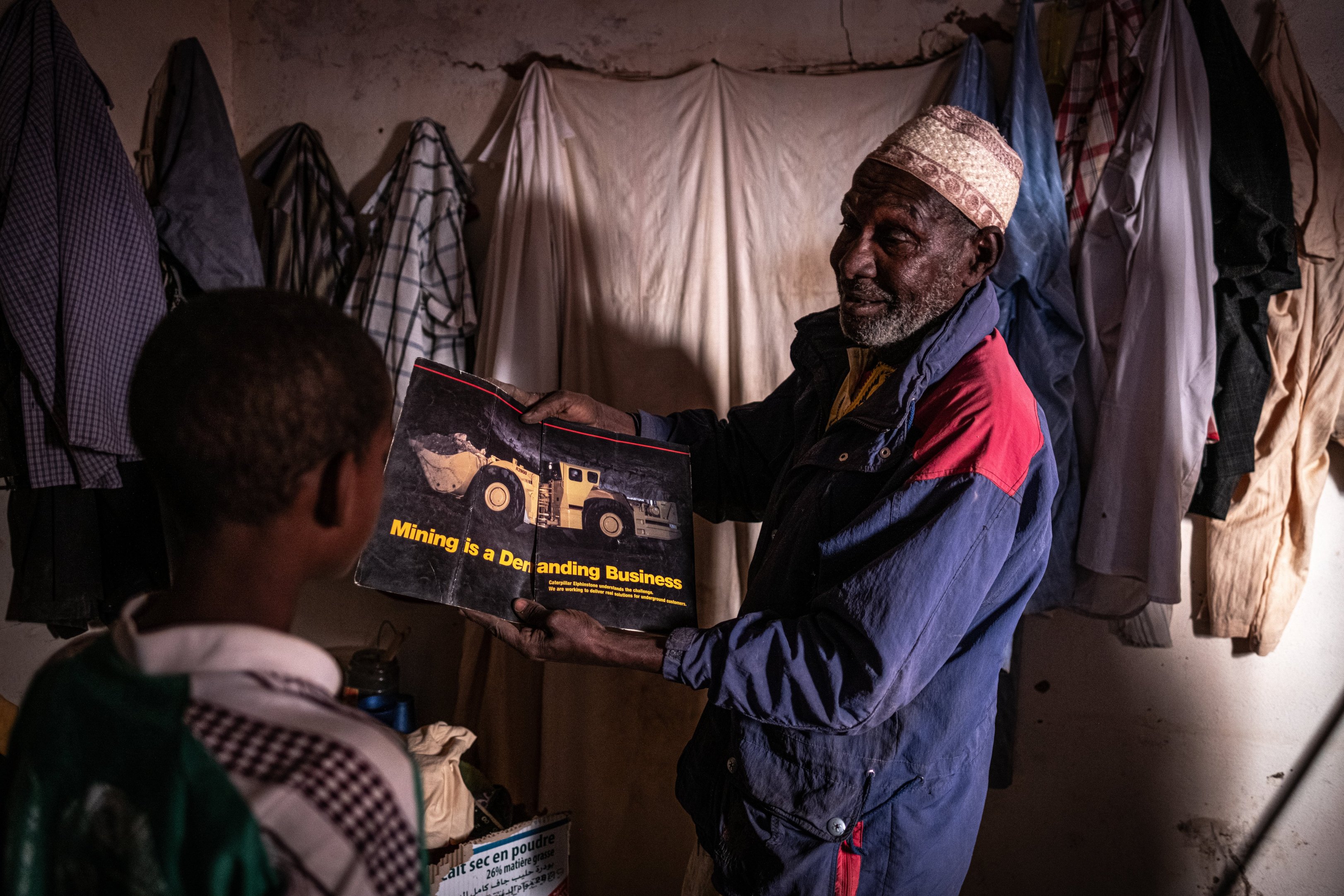
The old man now has vision and breathing problems and cannot afford medical check-ups even though he has several grandchildren and children to support, including a young disabled girl suffering from a severe malformation whom he has nevertheless managed to send to school. “That’s what the radiation does. There are many disabled people in the city who were born that way. Some have died, others are alive, it’s part of everyday life”, explains Boukari, who spends several hours a day teaching his children and grandchildren at home, where he has installed a blackboard. “If you haven’t studied, you can’t defend yourself and have a future. They must have a minimum of education if they want to pass the exam and enter the mine one day.” Despite the risks and consequences, Boukari hopes that they will also work in this industry...
A mirage still very real
More than half a century of mining has “upended the lives of nomadic Tuareg communities who have partly abandoned their customs to become miners and have also had to accept the arrival of other communities such as the Hausa, who were invited to come from the South to start industrialization. This has also created resentment and instability, as shown by the Tuareg uprisings of the 1990s”, explains researcher Emmanuel Grégoire, who has worked on uranium mining in Niger at the Research Institute for Development (IRD) in France.
After believing that “the metal of the future”, as the French presented it in the late 1960s, was going to change their lives, there is now no diversified development in the Agadez region that allows for other perspectives. “The idea that working in uranium brings economic stability, despite serious health problems, is deeply rooted in the community, because the first generations who started working in uranium earned a good living”, explains Emmanuel Grégoire. But this has not led to long-term prospects, because “the economic benefits have been very volatile due to the collapse of the uranium price at various stages in history”.
Niger is one of the least developed countries in the world (189th out of 193 in the Human Development Index ranking calculated by the United Nations Development Programme). Very low levels of access to electricity (19 %, according to the World Bank), education and health, and the effects of the climate crisis make it vulnerable. Yet, this country is one of the world’s largest uranium producers (7th worldwide), and the second supplier to the European Union (25 % in 2022). Despite the rise in the price of “yellowcake” in recent years (over $100 per pound in January 2024), Orano reportedin 2022 that it had paid only a total of 9.6 billion CFA francs (approximately 14.7 million euros) to the Nigerien state.
The beginning of the end ?
However, last year’s events may have definitively broken this form of relationship. The military junta in power, the National Council for the Safeguard of the Homeland (CNSP), led by General Abdourahamane Tiani, has made the revision of relations with the former colonial power one of its main mantras. The French ambassador left the country at the end of 2023, and with him the military deployed as part of Operation Barkhane. On June 20, 2024, the Nigerien government announced in a statement that it was withdrawing from Orano the mining permit for the Imouraren uranium deposit (located 80 km south of Arlit), considered one of the most important in the world - its reserves are estimated at more than 200,000 tons - and on which a convention had been renewed in 2023 for the start of exploitation in 2028. In the offices of the “Prisme”, the headquarters of Orano, in Châtillon (southwest of Paris), one could only take note of the decision of Niamey, even if the company reserves “the right to challenge the revocation decision before the competent national or international judicial authorities”.
Many analysts considered this scenario unlikely. Nevertheless, the new Nigerien authorities have opted for a hard line. The current government is convinced that the recent start of oil production in the Agadem region (in the east of the country) will compensate for any potential losses related to this decision.
Almoustapha Alhacen believes that renegotiating the exploitation contracts is necessary, but he does not think that finding “a replacement will automatically improve things” and he does not hide his concern for the future: “If Orano were to close, it would not necessarily be an advantage for us because we have been working there for a long time now. Business would stop, and Orano could also leave without taking responsibility for the damage caused, even if it is now irreparable”.

1Read Greenpeace, Oxfam, the Observatoire des multinationales, Sherpa and Criirad.
2On its website, Orano simply states that “5,600 buildings have been inspected”. Almoustapha Alhacen maintains that this is not enough, because even if contaminated buildings or sites are identified, many remain untouched.